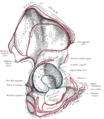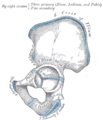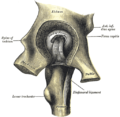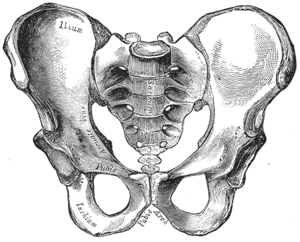Pelvis (anatomy)
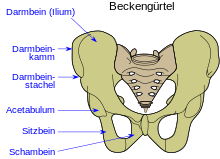
The pool ( Pelvis ) is in terrestrial vertebrates , the body portion below the abdomen and above the legs at four-footed mammals the part between belly and tail. In humans, a distinction is made between a large and a small pelvis ( pelvis major and pelvis minor ). The large pelvis lies between the two iliac blades above the pelvic entry line ( linea terminalis ) and actually belongs to the abdominal cavity .
At the same time, the term “pelvis” is understood to mean the bony part of this body section. The bony pelvis consists of the two hip bones ( ossa coxae ), which are part of the appended skeleton. Together with the sacrum ( os sacrum ) it forms the pelvic girdle or pelvic ring ( cingulum membri pelvini ). In mammals (including humans) the bony pelvis is articulated with the spine via the sacroiliac joint, but not very mobile. Thanks to its strength and stability, the pelvic belt gives the human body a secure stance and an upright posture. It also surrounds the pelvic cavity . In animals, it ensures that the hind limbs are firmly anchored to the trunk and that the thrust they produce is effectively transferred to the body. In crocodiles, the pelvic girdle supports lung ventilation.
Hip bone (os coxae)
Both hip bones consist of three parts each:
- Ilium ( ilium ),
- Ischium ( ischium ) and
- Pubic bone ( Os pubis ).
These three bones merge in humans around the age of 15 in the area of the acetabulum to form the now uniform hip bone.
Both hip bones are connected to the sacrum via the sacrum-iliac joint ( articulatio sacroiliaca ). This joint is an amphiarthrosis , i.e. a tight joint that can hardly make any movements, but is of great importance for the suspension of the spine. On the front side, the two hip bones have a cartilaginous connection via the pubic symphysis ( symphysis pubica ). In animals, the connection between the two hip bones is on the underside and includes the pubic and ischium ( symphysis pelvica ).
All three hip bones meet in the hip joint socket ( acetabulum ), which forms the hip joint with the head of the thigh bone .
Representation of the ossification of a hip bone
Sex differences in the bony pelvis and variations
The female and male pelvis in humans differ significantly. While in women the two pelvic blades are more expansive and the hipbone hole ( foramen obturatum ) has a more triangular shape, the male pelvis is high, narrow and narrow. The pelvic outlet is also wider in the female pelvis; the angle between the two pubic branches is greater than 90 ° in the female pelvis ( arcus pubicus ), while in the male pelvis it is only about 70 ° ( angulus subpubicus ). In anatomy and obstetrics , standardized conjugates (view from lateral) and diameters (view from cranial or caudal) are used to describe the shape of the pelvis.
Anatomical variations on the normal pelvis are the assimilation pelvis, in which the last lumbar vertebra is fused with the first sacral vertebra, and the horizontal overload pelvis according to Gutmann. In obstetrics, the assimilation pelvis is seen as an abnormal pelvis with a smaller transverse diameter and the funnel pelvis with a narrowed pelvic outlet as possible birth complications .
Diseases
Pelvic diseases are generally diseases of the bony pelvis, the pelvic cavity and the pelvic floor . This includes pelvic inflammation (pelvic inflammation ), an infection that can affect fallopian tubes, uterus and ovaries.
See also
literature
- Heinz Kirchhoff : The long basin: obstetric study on the assimilation basin. Thieme Verlag, Stuttgart 1949
Web links
Individual evidence
- ↑ elsetech: The pelvis, anatomy. In: elsetech knowledge database. elsetech, accessed on March 17, 2020 .
- ↑ Crocodiles breathe with their pelvic bones welt.de, November 25, 2001
- ↑ High assimilation basin according to Erdmann and Gutmann or loosening basin ( Memento from October 22, 2017 in the Internet Archive )
- ↑ Overload basin according to Gutmann ( Memento from October 22, 2017 in the Internet Archive )
- ↑ www.schwangerschaftsfahrplan.de: Anomalies of the bony birth canal ( page no longer available , search in web archives )
- ↑ Narrow pelvis, large heads and the difficult birth in humans, University of Vienna. Media portal. (April 20, 2015)
- ↑ Causes of pelvic diseases ihrymptome.de
- ↑ MSD Manuals: Pelvic Inflammation .



